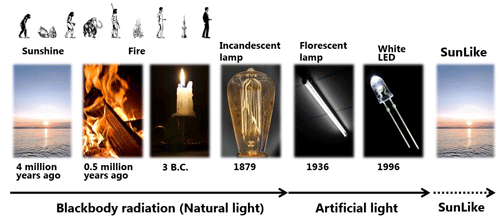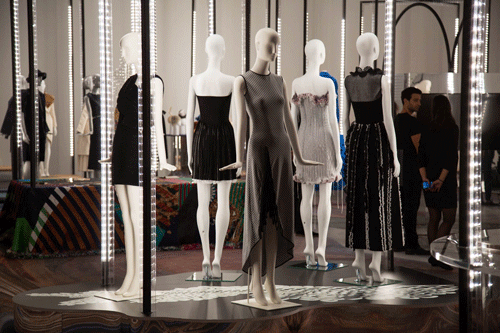Combined with the patented technology of Seoul Semiconductor LED chips and Toshiba Materials TRI-R phosphor technology, the SunLike series provides the industry's best quality light source for next-generation LED products, making human-centered illumination suitable for day and night rhythms.
Seoul Semiconductor, an innovator of global LED products and technologies, has developed a new LED technology that produces light close to the natural light spectrum. On June 26, 2017, Seoul Semiconductor announced at a press conference in Frankfurt, Germany. The new SunLike series of natural spectrum LED technology was jointly developed by Seoul Semiconductor and Toshiba Materials.

<Figure 1: Evolution of Light>
Return to natural light
Humans lived in the sun for thousands of years until the third century BC. The use of white LEDs on general lighting has not been more than 20 years, but due to its high luminous efficiency and cost-saving features, LED lighting is rapidly spreading throughout the world. However, compared to light quality, low cost and brightness are prioritized, so the characteristics of light produced by conventional LEDs are different from those of natural light that conforms to human body rhythms.
The SunLike series of LED technology is close to the spectrum of natural light that humans have enjoyed for thousands of years, maximizing the benefits of natural light, minimizing the shortcomings of artificial light sources, and producing more natural light. Natural light spectrum is achieved by combining Seoul Semiconductor's world-leading LED chip technology with Toshiba Materials TRI-R technology, the world's leading phosphor technology.
Mr. Kumpei Kobayashi, CEO of Toshiba Materials, said that he is very pleased to cooperate with global LED leaders such as Seoul Semiconductor to launch the SunLike series of natural spectrum LEDs, which represents an advanced technology that creates a more intimate and natural lighting environment.
Seoul Semiconductor CEO Li Yixun also said that it is a great honor to introduce another Korean innovative LED technology - SunLike series LED lighting technology, which produces light close to the natural light spectrum. Just as our package-free WICOP series revolutionizes the LED packaging process, our SunLike series represents a new revolution in creating natural light LED lighting. He added that the SunLike series of LEDs will be used in the lighting industry to provide a better and healthier life for humans. They are also suitable for horticultural lighting, creating an ideal environment to help plants grow, which is safer than using genetic modification.
He also said: "We are very pleased to work with Toshiba Materials to provide customers with a source of natural light - from the first sunshine in the morning to the energetic daylight to the warmth of the evening sun. We believe that the SunLike series of LEDs will improve. The quality of human life is driven by the advent of a new era of people-centered lighting.
Minimizing blue light side effects
The SunLike series of LEDs are designed to deliver light close to the natural spectrum, so they provide an optimized source of light for human-centered illumination, maximizing the benefits of natural light while minimizing the negative effects of artificial light.
Recent studies by Harvard University and other major universities have shown that most of the blue LED chips used in commercial lighting produce visible light, which can be positively irritating to the human eye during daytime viewing, thereby increasing alertness and elevating mood. However, these blue LEDs produce a blue "peak" in the light output, which can have a negative impact by interfering with the natural human biological rhythm when viewed for a long time at night. The SunLike Series Natural Spectrum LED technology uses a violet LED that, in combination with TRI-R phosphor technology, minimizes the "peak" of the blue light (a characteristic of a typical LED source), allowing the resulting light to be close to the natural light spectrum. Bring a healthier light experience.
SunLike's world of color reproduction
According to research published in academic journals such as Nature, humans have lived in the sun for thousands of years, and human organs and biological rhythms have evolved to make the most appropriate response to natural light. Human retinal cells (interpreting and responding to color-related light input) consist of three cones of red, blue, and green, while the proportion of cells that recognize blue is only 5.7%.

<Figure 2: Only 5.7% of S-cones in retinal cells can distinguish blue>
The amount of blue light that our eyes can accept is limited. When the blue light exceeds the limit, it will be scattered into the eye. When the scattering phenomenon occurs, the light will spread, so the texture and color of the object will be distorted. In addition, excessive blue light can over-stimulate retinal cells in the eye, which can lead to eye fatigue and inattention. However, because the SunLike series of LEDs achieve the closest spectrum to natural light, they more accurately represent the color and structure of objects in natural light, avoiding excessive blue light that negatively affects the eye or human biological rhythm. Many products using Toshiba TRI-R technology have been used for Milan Fashion Week lighting and installed in museums to illuminate art works.

<Figure 3: Craftsman • Inheritance: TRI-R technology illuminates the exhibition>
("Artist's Handwriting, Inheritance, World Famous Fashion Show - Milan Fashion Week, The Story of Craftsmanship and Innovation." This event was organized by Chamber of Fashion, Vogue Italy and ICE Agency at the MUDEC Museum in Milan)

<Figure 4: The birth of Rubens and Baroque style: TRI-R technology illuminates the exhibition>
(A special exhibition held in Milan from October 26, 2016 to February 26, 2017, held in the Royal Palace of Milan)
Application and market forecast
SunLike will be used primarily in commercial facilities that need to identify or display the exact color of the item being viewed in the sun, such as department stores, boutique jewellery, indoor planting facilities, exhibition facilities such as museums, exhibition halls, beauty facilities such as changing rooms, bathrooms. .
The global lighting market is estimated to be $87 billion, with LED lighting accounting for $35 billion. In the LED market, the overall share of the SunLike family of LEDs is $17 billion. It is expected that the SunLike series of natural spectrum LEDs will initially be used in luminaires that require high-quality lighting, and eventually move toward the general lighting market.

Draw-wire sensors of the wire sensor series measure with high linearity across the entire measuring range and are used for distance and position measurements of 100mm up to 20,000mm. Draw-wire sensors from LANDER are ideal for integration and subsequent assembly in serial OEM applications, e.g., in medical devices, lifts, conveyors and automotive engineering.
Linear Encoder,Digital Linear Encoder,Draw Wire Sensor,1500Mm Linear Encoder
Jilin Lander Intelligent Technology Co., Ltd , https://www.jilinlandertech.com